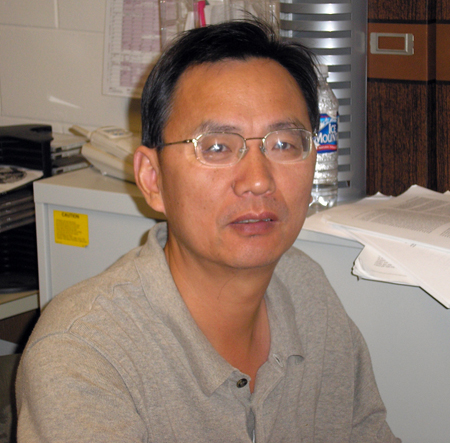Faculty: Xiche Hu, Ph.D.

Associate Professor
Email: xiche.hu@utoledo.edu
Office: WO 2277
Phone: (419) 530-1513
Fax: (419) 530-4033
Professional Background:
B.S. 1982 and M.S. 1985: Wuhan University (China)
Ph.D. 1991: Wayne State University
Postdoctoral Fellow:
1992-1994 Univ. of California at Irvine
1994-1998 Univ. of Illinois at Urbana-Champaign
Publications
Research Synopsis:
Computational/Theoretical Chemistry:
Modeling of membrane protein structures
X-ray crystallographic computing for protein structure determination
Chemical reaction dynamics
The photosynthetic unit (PSU) of purple bacteria consists of the photosynthetic reaction center surrounded by an array of light-harvesting complexes (LHs), involving hundreds of bacteriochlorophylls and carotenoids. The PSU constitutes a highly efficient machinery for absorbing and utilizing absorbed light quanta. Photons are absorbed by LHs and transferred in the form of electronic excitation towards the photosynthetic reaction center for photoinduced charge separation. A major thrust of my research program is computational modeling of the three dimensional structure of the bacterial PSU and theoretical studies of energy transfer mechanisms in the bacterial photosynthetic membrane based on the modeled structure of the PSU. The impact of this research will likely go beyond an understanding of bacterial light harvesting. Once the physical principles governing the light harvesting and electron transfer processes in the photosynthetic organisms, selected and optimized in billions of years of evolution, are understood, we may apply the same principles to engineer solar cells.
Membrane proteins are vital to many cellular and physiological processes. Knowledge of three dimensional structures of membrane proteins is urgently needed for understanding of their biological functions. A key bottleneck in X-ray crystallographic structure determination remains the so-called phase problem. To resolve a structure from measured diffraction intensities requires knowledge of phases which is unobtainable from a single diffraction experiment. Conventionally, the phase problem is solved by means of the multiple isomorphous replacement method, which requires two or more isomorphous heavy metal derivatives. An alternative solution to the phase problem is to phase the structure by using a homologous structure in a procedure called molecular replacement. In this method, a homologous probe structure is fit into the unit cell of the unknown structure and used to generate an initial phasing model for the unknown structure. Crystallization of isomorphous heavy metal derivatives is a tedious and sometimes impossible task. The conventional molecular replacement method relies solely on the availability of the structure of a highly homologous protein. To extend the applicability of the X-ray diffraction method, a major effort is currently underway to develop the ab initio molecular replacement method for X-ray crystallographic structure determination of membrane proteins. Here, the term ab initio stems from the fact that the probe model is computationally modeled by means of protein structure prediction methods rather than the structure of a homologous protein as in the conventional molecular replacement method. The emphasis is on developing novel methods for secondary/tertiary structure prediction of membrane proteins, and on advancing techniques for molecular replacement search.
A final direction of our research efforts lies in molecular level understanding of chemical reaction dynamics for both bimolecular (reactive and inelastic collision process) and unimolecular (vibrational energy redistribution, unimolecular decomposition) reactions by means of classical trajectory calculations. A typical classical trajectory calculation involves first determining a potential energy surface by solving the electronic Schrodinger equation for the energy as function of nuclear coordinates, and then solving for the nuclear motion on this potential energy surface with the classical equations of motion. Statistical averaging of multiple trajectories yields macroscopic properties such as reaction coefficient, and product energy partitioning.


